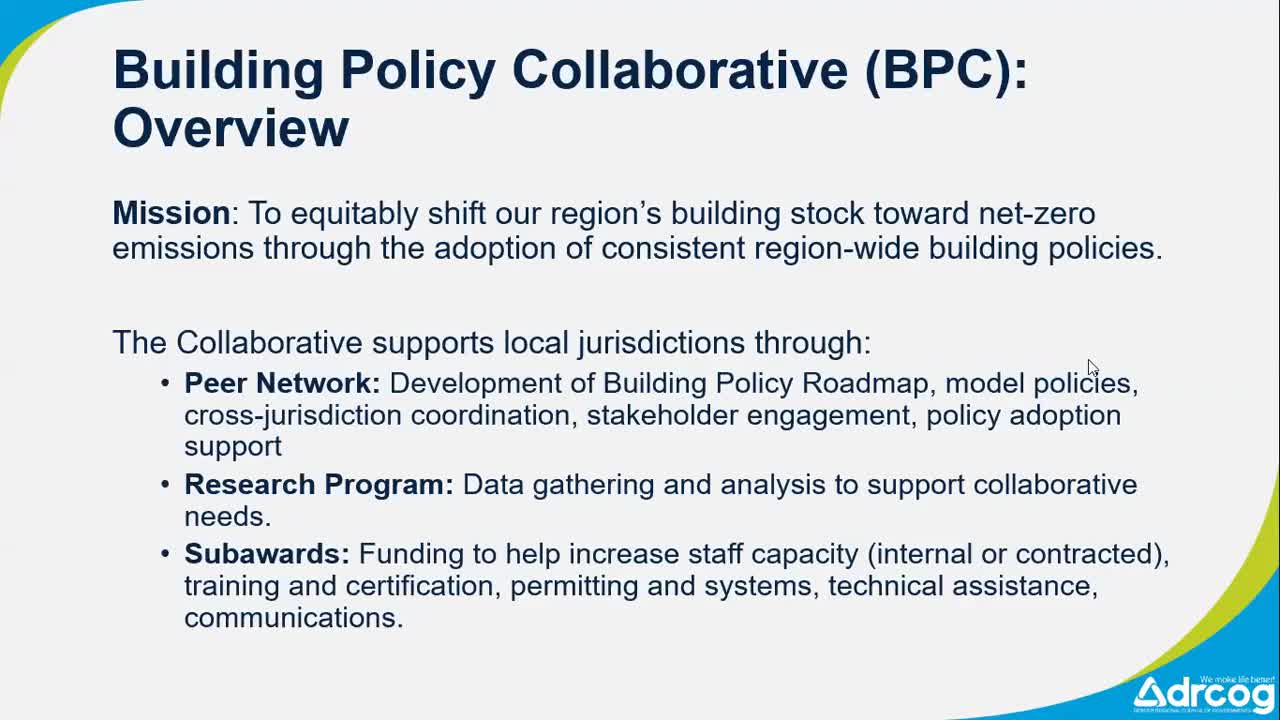Building Policy Collaborative obligates $25.95M in subawards; staff preview competitive Round 2 with equity and innovation goals
November 04, 2025 | Denver Regional Council of Governments, Governor's Boards and Commissions, Organizations, Executive, Colorado
This article was created by AI summarizing key points discussed. AI makes mistakes, so for full details and context, please refer to the video of the full meeting. Please report any errors so we can fix them. Report an error »

The Building Policy Collaborative staff reported the results of Round 1 of a jurisdictional subaward program intended to help local governments adopt building‑sector decarbonization policies. Greg Meow, program manager for the Building Policy Collaborative, said the program reserves $34.8 million for passthrough subawards from a $39 million program; staff have obligated $25,950,000 in Round 1 and expect approximately $8.8 million to remain for a competitive Round 2.
Crystal (program staff) said 27 of 64 eligible jurisdictions submitted applications, representing roughly 42 percent of jurisdictions in the regional program. Most proposals followed the previously adopted formula amounts and requested sums substantially larger than $300,000; only one jurisdiction (the town of Nederland) applied for its small $50,000 allotment. Most of the Round 1 awards were described as formula amounts tied to jurisdiction population and jobs.
Round 1 funding focused on policy-related activities: staff capacity (the most‑requested item), training and certification, technical assistance (including sustainability planning and greenhouse‑gas inventories), permitting and system updates, research, and locally led community engagement. Crystal said the most common immediate need was additional staffing capacity; applicants described using funds to hire internal staff or to retain contractors (for example, building‑code consultants) that can fill shortfalls temporarily.
Staff and committee members discussed patterns and gaps from Round 1. Crystal reported geographic gaps in applications — fewer mountain and southern communities participated — and an uptake concentrated among larger jurisdictions. Staff said a $50,000 formula allotment for the smallest jurisdictions proved insufficient to attract most small communities. Jurisdictions also reported limited staff capacity and raised questions about program guardrails and federal (EPA) grant expectations.
For Round 2, staff proposed a competitive process open to all jurisdictions and designed to increase participation by smaller communities, add an innovation scoring criterion for applicants that go beyond base formulas, and prioritize activities that address equity concerns, especially protections or benefits for low‑income households. Staff outlined a proposed timeline: draft policy and committee discussion in December, a committee recommendation to the full board in January, and an application window opening in February or March 2026 and closing after roughly three months (April–May 2026).
Staff recommended a two‑stage application process for Round 2: a short letter of intent (LOI) containing a tiered budget (minimum viable, standard, and stretch budgets) and a full application for shortlisted LOIs. That design, staff said, would let reviewers compare scalable proposals and match available funds to proposals to maximize obligations and impact. The committee agreed to use the breakout sessions to collect input on specific design questions such as eligible uses, guardrails (for example, excluding infrastructure and rebate programs), scoring weights, and ways to ensure funds benefit low‑income populations.
Greg and Crystal said staff will return to the committee with a formal draft for discussion in December and with a recommendation in January, aiming to open a competitive Round 2 in early 2026.
Crystal (program staff) said 27 of 64 eligible jurisdictions submitted applications, representing roughly 42 percent of jurisdictions in the regional program. Most proposals followed the previously adopted formula amounts and requested sums substantially larger than $300,000; only one jurisdiction (the town of Nederland) applied for its small $50,000 allotment. Most of the Round 1 awards were described as formula amounts tied to jurisdiction population and jobs.
Round 1 funding focused on policy-related activities: staff capacity (the most‑requested item), training and certification, technical assistance (including sustainability planning and greenhouse‑gas inventories), permitting and system updates, research, and locally led community engagement. Crystal said the most common immediate need was additional staffing capacity; applicants described using funds to hire internal staff or to retain contractors (for example, building‑code consultants) that can fill shortfalls temporarily.
Staff and committee members discussed patterns and gaps from Round 1. Crystal reported geographic gaps in applications — fewer mountain and southern communities participated — and an uptake concentrated among larger jurisdictions. Staff said a $50,000 formula allotment for the smallest jurisdictions proved insufficient to attract most small communities. Jurisdictions also reported limited staff capacity and raised questions about program guardrails and federal (EPA) grant expectations.
For Round 2, staff proposed a competitive process open to all jurisdictions and designed to increase participation by smaller communities, add an innovation scoring criterion for applicants that go beyond base formulas, and prioritize activities that address equity concerns, especially protections or benefits for low‑income households. Staff outlined a proposed timeline: draft policy and committee discussion in December, a committee recommendation to the full board in January, and an application window opening in February or March 2026 and closing after roughly three months (April–May 2026).
Staff recommended a two‑stage application process for Round 2: a short letter of intent (LOI) containing a tiered budget (minimum viable, standard, and stretch budgets) and a full application for shortlisted LOIs. That design, staff said, would let reviewers compare scalable proposals and match available funds to proposals to maximize obligations and impact. The committee agreed to use the breakout sessions to collect input on specific design questions such as eligible uses, guardrails (for example, excluding infrastructure and rebate programs), scoring weights, and ways to ensure funds benefit low‑income populations.
Greg and Crystal said staff will return to the committee with a formal draft for discussion in December and with a recommendation in January, aiming to open a competitive Round 2 in early 2026.
View full meeting
This article is based on a recent meeting—watch the full video and explore the complete transcript for deeper insights into the discussion.
View full meeting
